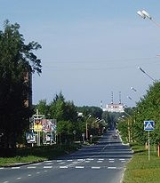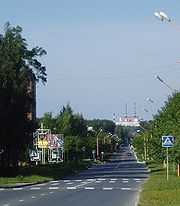
Beloyarsk Nuclear Power Station
Encyclopedia

Soviet Union
The Soviet Union , officially the Union of Soviet Socialist Republics , was a constitutionally socialist state that existed in Eurasia between 1922 and 1991....
nuclear plants. It is situated by Zarechny
Zarechny, Sverdlovsk Oblast
Zarechny is a town in Sverdlovsk Oblast, Russia, located on the Pyshma River east of Yekaterinburg. Population: It was granted urban-type settlement status in 1957; town status was granted in 1992....
in Sverdlovsk Oblast
Sverdlovsk Oblast
Sverdlovsk Oblast is a federal subject of Russia located in the Urals Federal District. Its administrative center is the city of Yekaterinburg formerly known as Sverdlovsk. Population: -Geography:...
, Russia. Zarechny township was created to service the station, which is named after the Beloyarsky District
Beloyarsky District, Sverdlovsk Oblast
Beloyarsky District is an administrative district , one of the 30 in Sverdlovsk Oblast, Russia. The district contains 2 Urban-type settlements and 11 selsovets under its jurisdiction....
. The closest city is Yekaterinburg
Yekaterinburg
Yekaterinburg is a major city in the central part of Russia, the administrative center of Sverdlovsk Oblast. Situated on the eastern side of the Ural mountain range, it is the main industrial and cultural center of the Urals Federal District with a population of 1,350,136 , making it Russia's...
.
Beloyarsk NPS was the first to put graphite
Graphite
The mineral graphite is one of the allotropes of carbon. It was named by Abraham Gottlob Werner in 1789 from the Ancient Greek γράφω , "to draw/write", for its use in pencils, where it is commonly called lead . Unlike diamond , graphite is an electrical conductor, a semimetal...
-moderated
Neutron moderator
In nuclear engineering, a neutron moderator is a medium that reduces the speed of fast neutrons, thereby turning them into thermal neutrons capable of sustaining a nuclear chain reaction involving uranium-235....
reactors into operation to produce electrical power
Electric power
Electric power is the rate at which electric energy is transferred by an electric circuit. The SI unit of power is the watt.-Circuits:Electric power, like mechanical power, is represented by the letter P in electrical equations...
. The single reactor now in operation is a BN-600
BN-600 reactor
The BN-600 reactor is a sodium-cooled fast breeder reactor, built at the Beloyarsk Nuclear Power Station, in Zarechny, Sverdlovsk Oblast, Russia. Designed to generate electrical power of 600 MW in total, the plant dispatches 560 MW to the Middle Urals power grid...
fast breeder reactor, generating 600 MWe. It is the largest fast neutron power reactor
Fast neutron reactor
A fast neutron reactor or simply a fast reactor is a category of nuclear reactor in which the fission chain reaction is sustained by fast neutrons...
in service in the world. Three turbines are connected to the reactor. The BN-600 reactor core is 1.03 metres (40.6 in) tall and has a diameter of 2.05 metres (80.7 in). It has 369 fuel
Nuclear fuel
Nuclear fuel is a material that can be 'consumed' by fission or fusion to derive nuclear energy. Nuclear fuels are the most dense sources of energy available...
assemblies, each consisting of 127 fuel rods with an enrichment of 17-26% U235
Uranium-235
- References :* .* DOE Fundamentals handbook: Nuclear Physics and Reactor theory , .* A piece of U-235 the size of a grain of rice can produce energy equal to that contained in three tons of coal or fourteen barrels of oil. -External links:* * * one of the earliest articles on U-235 for the...
. In comparison, typical enrichment in other Russian reactors is in the range of 3-4% U235. BN-600 reactors use liquid sodium
Sodium
Sodium is a chemical element with the symbol Na and atomic number 11. It is a soft, silvery-white, highly reactive metal and is a member of the alkali metals; its only stable isotope is 23Na. It is an abundant element that exists in numerous minerals, most commonly as sodium chloride...
as a coolant. As with most Russian nuclear power plants the station lacks a containment building
Containment building
A containment building, in its most common usage, is a steel or reinforced concrete structure enclosing a nuclear reactor. It is designed, in any emergency, to contain the escape of radiation to a maximum pressure in the range of 60 to 200 psi...
.
Two earlier reactors were constructed at Beloyarsk: an AMB-100 reactor (operational 1964-1983) and an AMB-200 reactor (operational 1967-1989).
Construction started on a larger BN-800 type fast breeder reactor in 1987. Protests halted progress in 1988, but work resumed in 1992 following an order by President Boris Yeltsin
Boris Yeltsin
Boris Nikolayevich Yeltsin was the first President of the Russian Federation, serving from 1991 to 1999.Originally a supporter of Mikhail Gorbachev, Yeltsin emerged under the perestroika reforms as one of Gorbachev's most powerful political opponents. On 29 May 1990 he was elected the chairman of...
. Financial difficulties have resulted in slow progress. Construction costs have been estimated at 1 trillion rubles
Russian ruble
The ruble or rouble is the currency of the Russian Federation and the two partially recognized republics of Abkhazia and South Ossetia. Formerly, the ruble was also the currency of the Russian Empire and the Soviet Union prior to their breakups. Belarus and Transnistria also use currencies with...
and the new reactor can only be finished in 2012–2015 given current scarce financing. The BN-600 was originally planned to be decommissioned in 2010 but its lifetime is likely to be extended to cover the gap; it has been operating for 28 years so far.
Accidents
The two gravest incidents at Beloyarsk Nuclear Power Plant struck the two reactors which are now shut down. In 1977 half of the fuel rods melted down in the ABM-200 reactor. Operators were exposed to severe radiation doses and the repair work took more than a year. In December 1978 the same reactor caught fire when parts of the roof fell on one of the turbines' oil tanks. Cables were destroyed by the fire and the reactor went out of control. Eight people who assisted in securing cooling of the reactor core were exposed to increased radiation doses.In recent years there have been problems with leakage of liquid metal from the BN-600 cooling system. In December 1992 there was a leakage of radioactive contaminated water at the reactor. In October 1993 increased concentrations of radioactivity in the power plant fan system were found. A leakage the following month led to a shutdown. In January and May 1994 there was a fire at the power plant. In July 1995 another leakage of liquid metal from the cooling elements caused a two-week shutdown of the reactor.
There is an increasing concern about radioactive contamination around the power plant. Several hotspots were discovered in the region as the radiation monitoring effort was extended in recent years.
| Unit | Type | El. Output (MW) | Start of project | First criticality | Shut down |
|---|---|---|---|---|---|
| 1 | AMB-100 | 108 | 1958/06/01 | 1964/04/26 | 1983/01/01 |
| 2 | AMB-200 | 160 | 1962/01/01 | 1967/12/29 | 1990/01/01 |
| 3 | BN-600 | 600 | 1969/01/01 | 1980/04/08 | |
| 4 | BN-800 | 880 | 1987 | exp. Q1 2013 | |
| 5 | BN-1200 | ~1200 | 2012 | 2018-2020 |
Sources
External links
- Beloyarsk NPP, INSP programme

